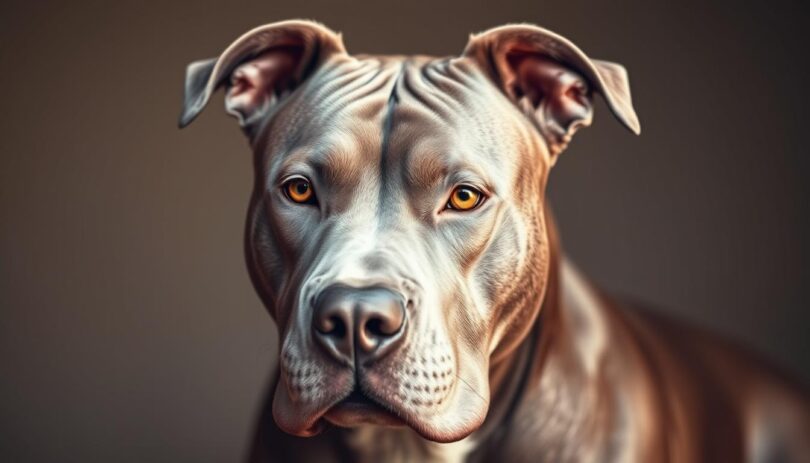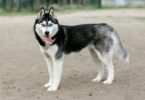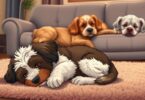What if the rarest dogs make the most devoted pets? Among the many misunderstood breeds, grey pitbulls stand out not just for their striking appearance but for their surprising role as affectionate family members. Their unique silver-toned coats—a result of a recessive gene diluting traditional colors—make them a rare sight, yet their loving temperament often leaves lasting impressions.
These athletic dogs combine strength with gentle loyalty, thriving in active households. While they share traits with other pit bulls, their genetic makeup influences more than just color. It subtly shapes their expressive eyes and muscular build, creating a visual signature as memorable as their playful personalities.
Contrary to stereotypes, well-socialized grey pitbulls display remarkable patience, especially with children. Their caring nature shines when raised with consistent training and positive reinforcement. Like their blue nose pitbull breed relatives, they form deep bonds with owners who appreciate their intelligence and energy.
This guide explores their history, the science behind their coat variations, and practical care strategies. You’ll discover why these companions excel in homes that value both adventure and cozy evenings. Ready to unravel what makes them truly one-of-a-kind?
Breed Overview and Distinctive Traits
Have you ever wondered why certain dogs become instant eye-catchers? These muscular companions blend power with elegance, standing 17–21 inches tall and weighing 30–60 pounds. Their lifespan of 12–14 years makes them long-term family members when cared for properly.
Physical Characteristics and Appearance
Built like athletes, these dogs showcase broad shoulders and a defined jawline. While similar to the American Staffordshire Terrier, their leaner frame distinguishes them from bulkier cousins. The recessive gene dilutes traditional black or brown coats into smoky silver hues, often accented with fawn undertones or brindle patterns.
Unlike the compact Staffordshire Bull Terrier, they have longer legs and a more streamlined silhouette. Their short, glossy coat requires minimal grooming but highlights their muscular definition. Color variations often spark curiosity about their genetic makeup—a topic we’ll explore deeper next.
Temperament and Behavioral Highlights
Beneath their strong appearance lies a heart of gold. These dogs thrive on human interaction, displaying loyalty that rivals even the American Pitbull Terrier. Early socialization shapes their caring nature, turning them into patient playmates for respectful children.
Their intelligence shines during training sessions, especially with reward-based methods. While some dog breeds lean toward independence, this breed seeks constant companionship. Proper guidance helps channel their energy into positive behaviors, making them adaptable to both active adventures and quiet evenings at home.
The Genetic Mystery Behind Grey Pitbulls
Genetics hold the key to unlocking why some dogs wear their uniqueness in their coats. While many assume coat colors are purely cosmetic, they often reveal hidden biological stories written in DNA. For silver-coated companions, a rare combination of inherited traits creates their signature hue.
Recessive Gene and Color Dilution
A recessive gene must come from both parents to produce diluted colors. Unlike dominant black coats that overpower other pigments, this gene weakens pigment distribution in each hair follicle. The result? A smoky blue-grey appearance where dark pigment clusters around the hair’s center, creating an optical illusion of silver.
Breeders face challenges maintaining healthy gene pools when prioritizing rare colors. Two carriers of the dilution gene must mate, which limits breeding options. This genetic dance also influences patterns like brindle stripes or fawn undertones, adding layers to each dog’s individuality.
Comparing Grey with Dominant Coat Colors
Dominant black coats appear solid and intense, while diluted versions seem softer and more textured. The difference stems from how melanin distributes—evenly in dominant hues versus patchy in diluted ones. American Bully lineage occasionally introduces deeper blue-grey tones, further diversifying outcomes.
Understanding these genetic nuances helps owners appreciate their dog’s unique biology. It also prepares breeders to make informed decisions, balancing aesthetics with health. Next, we’ll explore how history shaped these remarkable canines into modern companions.
A Journey Through Grey Pitbull History
How did silver-coated dogs transition from fighting rings to family rooms? Their story begins in 19th-century Britain, where breeders crossed Old English Bulldogs with terriers. These early mixes combined strength with agility, traits valued for bull-baiting sports before the 1835 Cruelty to Animals Act outlawed such practices.
From Old English Bulldogs to Modern Companions
After bull-baiting bans, these dogs found new roles as farm helpers and ratters. Their intelligence and loyalty caught attention, leading to selective breeding for temperament. By the 1970s, legislative crackdowns on dog fighting pushed the breed toward companionship roles. Modern training shifted from harsh methods to positive reinforcement, nurturing their natural desire to please.
Media portrayals in the late 20th century damaged their reputation, but dedicated owners showcased their true nature. Television ads and family-focused social media posts highlighted their patience with children. American Staffordshire bloodlines introduced broader head shapes while preserving their signature muscular build.
Today’s silver-coated dogs carry echoes of their past in their genetic makeup. Their athletic frames and protective instincts now serve as therapy animals and search-and-rescue partners. As we move from history to present-day care, understanding their journey helps owners build fulfilling relationships with these reformed champions.
Health, Training, and Care Essentials
What separates good pet ownership from great? For active breeds, it’s balancing physical care with behavioral guidance. These dogs thrive when their needs align with structured routines and preventative health practices.
Managing Health Risks and Genetic Challenges
Common health problems include hip dysplasia and skin allergies, often linked to genetic diversity. Routine vet checkups help catch issues early. Like bull terriers, some may develop eye conditions requiring regular monitoring.
A balanced diet supports joint health and reduces allergy flare-ups. Breed-specific supplements can address deficiencies. Always discuss heart screenings with your vet—this proactive approach improves quality of life.
Effective Training and Socialization Strategies
Proper training starts with positive reinforcement. Reward calm behavior with treats or playtime. Socialize puppies early with diverse environments to build confidence.
High-energy breeds need 60+ minutes of daily exercise. Combine walks with puzzle toys for mental stimulation. Structured routines prevent boredom-related chewing or digging.
When raised with consistency, these dogs make excellent family pets. Their protective instincts shine through gentle interactions, especially with younger family members. Pair training with health management for a happy, well-adjusted companion.
Grey Pitbull in the Landscape of Pitbull Breeds
At first glance, many assume all muscular terrier-type dogs share identical traits. Closer inspection reveals distinct differences that influence their roles as companions. Let’s unpack how silver-coated variants fit into the broader pitbull family.
Physical Distinctions and Shared Lineage
The Staffordshire Bull Terrier stands shorter and stockier, while the American Staffordshire Terrier boasts a heavier build. Silver-coated dogs lean toward a more athletic frame—longer legs and a streamlined silhouette enhance their agility. Their diluted coat color stems from a recessive gene rarely seen in these cousin breeds.
All three share protective instincts and high energy levels. However, training approaches vary slightly. Staffordshires may show more stubbornness, while silver-coated dogs often respond faster to reward-based methods. Early socialization remains critical for all to nurture their naturally affectionate side.
Breeding Priorities and Color Genetics
Producing smoky-gray coats requires both parents to carry the dilution gene—a specific focus in selective breeding. Other pitbull types prioritize structure or temperament over rare color traits. This genetic emphasis creates unique care considerations, like monitoring for skin sensitivities linked to diluted pigments.
Despite these differences, all benefit from active lifestyles and consistent routines. Their shared ancestry means similar nutritional needs and exercise requirements. Prospective owners should assess whether a rare-coated companion aligns with their ability to meet specialized breeding-related health considerations.
Understanding these nuances helps families choose the best fit. Next, we’ll explore how one variant’s loyalty transforms households into lifelong bonds.
Why the Grey Pitbull Makes a Remarkable Family Companion
Few breeds match the heartfelt devotion silver-coated dogs bring to households. Their blend of warmth and resilience creates bonds that transform families, offering unwavering loyalty paired with playful energy.
Affectionate Nature and Loyalty
These dogs thrive on human connection, often following owners from room to room. Their sensitive disposition makes them attuned to family emotions, offering comfort during stressful moments. Early socialization helps them develop gentle patience, especially around children.
Consistent training unlocks their natural intelligence. Reward-based methods work best, as they aim to please. Structured routines channel their energy into positive behaviors, creating reliable companions who adapt to various living situations.
Ideal for Active and Experienced Pet Parents
Active households benefit most from their high stamina. Daily hikes, fetch sessions, or agility training keep them mentally and physically engaged. Experienced owners appreciate their eagerness to learn, using interactive games to strengthen bonds.
Like their brindle-patterned relatives, these pitbulls require confident leadership. Clear boundaries and regular exercise prevent boredom, allowing their affectionate nature to shine. Families who invest time reap the rewards of a loyal, protective friend.
Signing Off with Final Thoughts on Embracing the Grey Pitbull
In a world of common companions, some dogs redefine loyalty through both genes and heart. Grey pitbulls stand apart with their rare smoky coats—a marvel of recessive genes passed down from both parents. Their historical roots in Old English bulldogs evolved into modern devotion, proving nurture shapes nature.
Brindle streaks or fawn undertones add character to their signature blue-grey hues, while their athletic build reflects centuries of selective breeding. What truly captivates isn’t just their coat, but their balanced temperament. Proper training transforms them into patient playmates, disproving outdated stereotypes.
These dogs thrive when owners prioritize health screenings and consistent routines. Their genetic uniqueness demands mindful care, but rewards families with unwavering loyalty. Whether showcasing American Bully lineage or subtle terrier traits, they adapt to diverse households.
Prospective pet parents should celebrate their blend of strength and sensitivity. Look beyond the coat’s science to the dog’s heart—where resilience meets affection. Grey pitbulls don’t just join families; they deepen them through every tail wag and gentle nudge.
FAQ
What causes the grey coloration in these dogs?
The unique grey hue results from a recessive gene that dilutes standard coat colors like black or brown. This genetic trait affects pigment distribution, creating their signature silvery appearance.
Are there specific health concerns linked to their coat color?
Dogs with diluted coats, including grey variants, may face higher risks of skin sensitivities and allergies. Regular vet checkups and hypoallergenic grooming routines help manage these challenges.
How does their temperament compare to other Pitbull breeds?
Like American Staffordshire Terriers and Staffordshire Bull Terriers, they’re known for loyalty and affection. Proper socialization and consistent training amplify their naturally people-oriented behavior.
Are they suitable for first-time dog owners?
Their intelligence and eagerness to please make them trainable, but their strength and energy often suit households with prior experience handling active, muscular breeds.










Leave a Comment